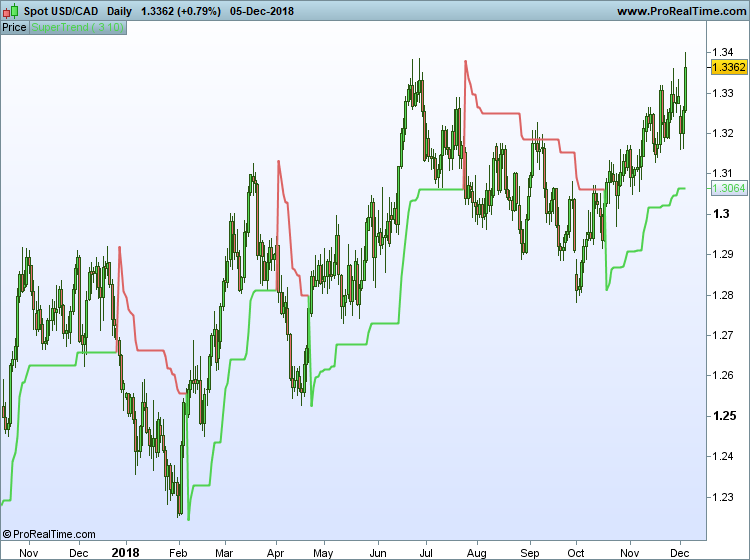Introduction
The Supertrend indicator might not be one of the most widely used technical indicators, but it is definitely one of the most useful because it basically tells you the current trend for any forex pair (and in any given time frame) that you wish to look at.
You will find that it broadly moves in line with the underlying price and will either be green (indicating a bullish trend) or red (indicating a bearish trend). So it is very easy to use.

Where To Find This Indicator
I generally use the IG.com charts when trading the forex and stock markets because these use the ProRealTime platform, and the Supertrend indicator is available here if you wish to use it.
However I understand that it is also available with charting platforms such as Metatrader and with the charting software used by various different brokers, including Ninjatrader. However you may have to import the code from elsewhere if it’s not included as standard.
How To Use The Supertrend Indicator
The Supertrend indicator is very good at indicating the current trend, and therefore helping you determine whether you should be taking long or short positions, but I have always found it to be even more useful when it indicates a change of trend, ie when it switches from green to red or vice versa.
(Note that the price has to actually close above or below this indicator when the latest bar closes in order for it to change color and signal the start of a new trend).
It’s not necessarily that helpful on the shorter time frames because you get a lot of false moves, but it can be invaluable on the longer term charts, particularly after a peak or trough in the market or after a long period of sideways consolidation.
In addition, you can also this indicator to determine where you should place your stop losses because placing it a few pips below the Supertrend indicator if it is currently green, or a few pips above if it is currently red makes a lot of sense.
Default Settings
The default settings are 3,10, with 3 being the multiplier and 10 being the number of periods.
However you can adjust the multiplier down to get you into a trend quicker, or adjust it upwards to make it less sensitive to price changes, but 3 is pretty much the best setting in my experience.
You can also play around with the number of periods if you so wish, but once again I think it’s best just to use the default setting.
Final Thoughts
I wouldn’t necessarily recommend that you enter positions based solely on the Supertrend indicator because you do get a lot of false moves, and it can sometimes get you into a new trend a little bit late.
However if it clearly signals a breakout move after a long period of sideways consolidation, or if it clearly signals a trend reversal on one of the longer time frames, the Supertrend indicator can provide some great signals. This is particularly true if it is backed up by a few other indicators and some tell-tale candlestick patterns, for instance.
It can also be very useful if you use multiple Supertrend indicators on the same chart.
To demonstrate this point, check out this trading strategy that aims to capture the long-term trends on the daily and weekly charts just by using four separate Supertrend indicators with different settings.

Leave a Reply